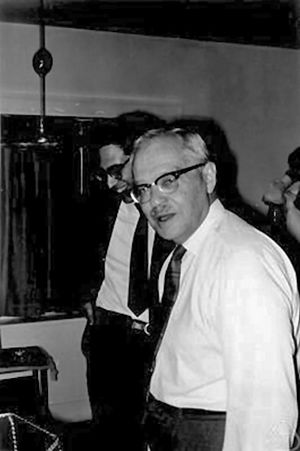Jerzy Neyman facts for kids
Quick facts for kids
Jerzy Neyman
|
|
|---|---|
 |
|
| Born |
Jerzy Spława-Neyman
April 16, 1894 Bendery, Bessarabia Governorate, Russian Empire (now Bender, Moldova)
|
| Died | August 5, 1981 (aged 87) Oakland, California, US
|
| Nationality | Polish |
| Alma mater | University of Warsaw Kharkov University |
| Known for | Neyman construction Neyman–Pearson lemma Neyman–Rubin causal model Fisher–Neyman factorization theorem Confidence interval Hypothesis testing Statistics of galaxy clusters |
| Awards | Newcomb Cleveland Prize (1958) Guy Medal (Gold, 1966) National Medal of Science (1968) Fellow of the Royal Society |
| Scientific career | |
| Fields | Mathematics |
| Institutions | Nencki Institute of Experimental Biology University College London University of California, Berkeley |
| Doctoral advisor | Wacław Sierpiński |
| Doctoral students | George Dantzig Lucien Le Cam Evelyn Fix Erich Leo Lehmann Joseph Hodges Pao-Lu Hsu |
Jerzy Neyman (April 16, 1894 – August 5, 1981; born Jerzy Spława-Neyman; Polish: [ˈjɛʐɨ ˈspwava ˈnɛjman]) was a Polish mathematician and statistician who spent the first part of his professional career at various institutions in Warsaw, Poland and then at University College London, and the second part at the University of California, Berkeley. Neyman first introduced the modern concept of a confidence interval into statistical hypothesis testing and co-revised Ronald Fisher's null hypothesis testing (in collaboration with Egon Pearson).
Life and career
He was born into a Polish family in Bendery, in the Bessarabia Governorate of the Russian Empire, the fourth of four children of Czesław Spława-Neyman and Kazimiera Lutosławska. His family was Roman Catholic, and Neyman served as an altar boy during his early childhood. Later, Neyman would become an agnostic. Neyman's family descended from a long line of Polish nobles and military heroes. He graduated from the Kamieniec Podolski gubernial gymnasium for boys in 1909 under the name Yuri Cheslavovich Neyman. He began studies at Kharkiv University in 1912, where he was taught by Ukrainian probabilist Sergei Natanovich Bernstein. After he read 'Lessons on the integration and the research of the primitive functions' by Henri Lebesgue, he was fascinated with measure and integration.
In 1921, he returned to Poland in a program of repatriation of POWs after the Polish-Soviet War. He earned his Doctor of Philosophy degree at University of Warsaw in 1924 for a dissertation titled "On the Applications of the Theory of Probability to Agricultural Experiments". He was examined by Wacław Sierpiński and Stefan Mazurkiewicz, among others. He spent a couple of years in London and Paris on a fellowship to study statistics with Karl Pearson and Émile Borel. After his return to Poland, he established the Biometric Laboratory at the Nencki Institute of Experimental Biology in Warsaw.
He published many books dealing with experiments and statistics, and devised the way which the FDA tests medicines today.
Neyman proposed and studied randomized experiments in 1923. Furthermore, his paper "On the Two Different Aspects of the Representative Method: The Method of Stratified Sampling and the Method of Purposive Selection", given at the Royal Statistical Society on 19 June 1934, was the groundbreaking event leading to modern scientific sampling. He introduced the confidence interval in his paper in 1937. Another noted contribution is the Neyman–Pearson lemma, the basis of hypothesis testing.
He was an Invited Speaker of the ICM in 1928 in Bologna and a Plenary Speaker of the ICM in 1954 in Amsterdam.
In 1938, he moved to Berkeley, where he worked for the rest of his life. Thirty-nine students received their Ph.Ds under his advisorship. In 1966, he was awarded the Guy Medal of the Royal Statistical Society and three years later the U.S. National Medal of Science. He died in Oakland, California in 1981.
See also
- List of Poles

